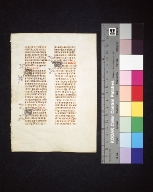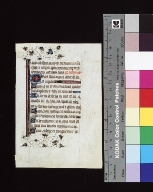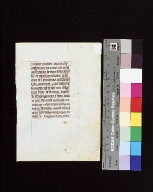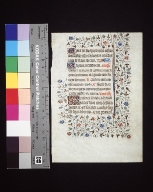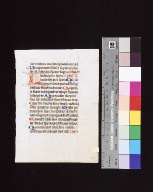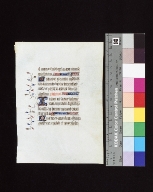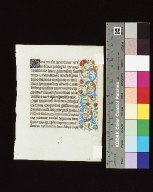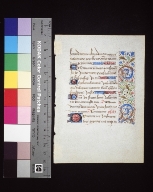|
REFINE
Browse All : Books of hours - Illustrations
1-10 of 10
Title
Horae Beatae Mariae Virginis: fragment
Creator
Catholic Church
Summary
[Ms. This manuscript leaf is part of a collection of medieval manuscript leaves selected to illustrate the art of the manuscript during the period of its greatest development and influence. They have been taken from books written in various European scriptoria by Benedictine, Franciscan, Carthusian, Dominican, and other orders of monks. Many are enriched with handsome borders, initial letters, and line-endings rendered in color. Twenty-five are illuminated with burnished gold or silver. The texts include the Bible, various church service books, the writings of the Church fathers, and some of the Classics., In angular gothic script, This particular Book of Hours, a devotional prayer book for the layman, was made for the use of Sarum, the early name for Salisbury, England. This text was accepted throughout the province of Canterbury. The manuscript was written about the time Chaucer completed his Canterbury Tales, but evidently by a French monk, who might have been attached, as was often the case, to an English monastery. Again, the book could have been specially ordered and imported from abroad. The initial letter and the coloring and the treatment of the ivy are unmistakably French. The lettering is an excellent example of the then current book hand. There are seven lines of writing to an inch. The words written in red, a heavy color made from mercury and sulphur, show almost the same degree of delicacy as those written with the more fluid ink.]
Title
Horae Beatae Mariae Virginis: fragment
Creator
Catholic Church
Summary
[Ms. This manuscript leaf is part of a collection of medieval manuscript leaves selected to illustrate the art of the manuscript during the period of its greatest development and influence. They have been taken from books written in various European scriptoria by Benedictine, Franciscan, Carthusian, Dominican, and other orders of monks. Many are enriched with handsome borders, initial letters, and line-endings rendered in color. Twenty-five are illuminated with burnished gold or silver. The texts include the Bible, various church service books, the writings of the Church fathers, and some of the Classics., In angular gothic script, This Book of Hours shows definite characteristics of the manuscript art of France and the Netherlands of about 1450 A.D. It was probably one of many copies prepared for sale at a shrine to which devout pilgrims came to worship or to seek a cure. The spiked letters and the detached ornamental bar are unmistakably Flemish in spirit, while the free ivy sprays are distinctively French. The burnished metal in the decorations shows the use of alloyed gold (oro di metà) as well as silver. Various metals were added in different localities to the fine gold. English illuminations frequently had a decided orange hue, while the French had a lemon cast. The quality of the gold was best enhanced by the use of burnishing tools equipped with an emerald, a topaz, or a ruby. Less successful burnishers contained an agate or the tooth of a wolf, a horse, or a dog. This vellum leaf was created in Northern France.]
Title
Horae Beatae Mariae Virginis: fragment
Creator
Catholic Church
Summary
[Ms. This manuscript leaf is part of a collection of medieval manuscript leaves selected to illustrate the art of the manuscript during the period of its greatest development and influence. They have been taken from books written in various European scriptoria by Benedictine, Franciscan, Carthusian, Dominican, and other orders of monks. Many are enriched with handsome borders, initial letters, and line-endings rendered in color. Twenty-five are illuminated with burnished gold or silver. The texts include the Bible, various church service books, the writings of the Church fathers, and some of the Classics., In angular gothic script, It is generally no great task to assign these illuminated Books of Hours to a particular country or period. The treatment of the ivy spray with the single line stem and rather sparse foliage is characteristic of the work of the French monastic scribes about the year 1450 A.D. The occasional appearance of the strawberry indicates that the illuminating was done by a Benedictine monk. Fifty years earlier the stem would have been wider and colored, and the foliage rich; fifty years later the ivy and holly leaves would be entangled with flowers and acanthus foliage. This vellum leaf was created in France.]
Title
Horae Beatae Mariae Virginis: fragment
Creator
Catholic Church
Summary
[Ms. This manuscript leaf is part of a collection of medieval manuscript leaves selected to illustrate the art of the manuscript during the period of its greatest development and influence. They have been taken from books written in various European scriptoria by Benedictine, Franciscan, Carthusian, Dominican, and other orders of monks. Many are enriched with handsome borders, initial letters, and line-endings rendered in color. Twenty-five are illuminated with burnished gold or silver. The texts include the Bible, various church service books, the writings of the Church fathers, and some of the Classics., In angular gothic script, The text of a Book of Hours consists of Gospels of the Nativity, prayers for the Canonical Hours, the Penitential Psalms, the Litany, and other prayers. The beauty of the rich borders found in some of these books frequently claims our attention more than the text. In these borders it is easy to recognize the ivy leaf and the holly, but is usually more difficult to identify the daisy, thistle, cornbottle, and wild stock. The monks had no hesitancy in letting these flowers grow from a common stem. Because of the translucency of vellum, the flowers, stems, and leaves of the border were carefully superimposed on the reverse side in order to avoid a blurred effect. This vellum leaf was created in France.]
Title
Horae Beatae Mariae Virginis: fragment
Creator
Catholic Church
Summary
[Ms. This manuscript leaf is part of a collection of medieval manuscript leaves selected to illustrate the art of the manuscript during the period of its greatest development and influence. They have been taken from books written in various European scriptoria by Benedictine, Franciscan, Carthusian, Dominican, and other orders of monks. Many are enriched with handsome borders, initial letters, and line-endings rendered in color. Twenty-five are illuminated with burnished gold or silver. The texts include the Bible, various church service books, the writings of the Church fathers, and some of the Classics., In bold angular gothic script, In general, the Books of Hours produced for the devout layman in the Netherlands at the end of the 15th century were written in Dutch. This particular example, however, is in Latin. The heavy, angular, and closely spaced vertical strokes, with very short ascenders and descenders, give a much darker tone to the page than to similar scripts in such northern countries as Germany and England. This book hand resembles very closely the types known as lettre de forme which were used by certain anonymous contemporary printers in the Netherlands between 1470 and 1500 A.D. This vellum leaf was created in the Netherlands.]
Title
Horae Beatae Mariae Virginis: fragment
Creator
Catholic Church
Summary
[Ms. This manuscript leaf is part of a collection of medieval manuscript leaves selected to illustrate the art of the manuscript during the period of its greatest development and influence. They have been taken from books written in various European scriptoria by Benedictine, Franciscan, Carthusian, Dominican, and other orders of monks. Many are enriched with handsome borders, initial letters, and line-endings rendered in color. Twenty-five are illuminated with burnished gold or silver. The texts include the Bible, various church service books, the writings of the Church fathers, and some of the Classics., In gothic script, This manuscript leaf came from a Book of Hours, sold probably at one of the famous shrines to which wealthy laymen made pilgrimages. To meet the demand for these books, the monastic as well as the secular scribes produced them in great numbers. The freely drawn, indefinite buds here entirely supplant the ivy, fruits, and realistic wayside flowers which characterized the borders of manuscripts of the preceding half century. The initial letters of burnished gold on a background of old rose and blue with delicate white line decorations maintain the tradition of the earlier period. The vellum is of silk-like quality that often distinguished the manuscripts of France and Italy.]
Title
Horae Beatae Mariae Virginis: fragment
Creator
Catholic Church
Summary
[Ms. This manuscript leaf is part of a collection of medieval manuscript leaves selected to illustrate the art of the manuscript during the period of its greatest development and influence. They have been taken from books written in various European scriptoria by Benedictine, Franciscan, Carthusian, Dominican, and other orders of monks. Many are enriched with handsome borders, initial letters, and line-endings rendered in color. Twenty-five are illuminated with burnished gold or silver. The texts include the Bible, various church service books, the writings of the Church fathers, and some of the Classics., In gothic script, The Book of Hours, the prayer book of laity, usually contains 16 sections. The section on prayers to the Virgin is the most important and most used, and its manuscripts exceed in number all other 15th century religious texts. The laymen who ordered and purchased these books would at times stipulate the style of ornament and the amount of burnished gold to be used, and could even, to a certain extent, select the saints they esteemed most and wished to glorify. In this example, the border reveals by its wayside flowers entangled with the heavy acanthus motif of the North and by the use of "wash" gold that it was executed in Northern France about 1475 A.D.]
Title
Horae Beatae Mariae Virginis: fragment
Creator
Catholic Church
Summary
[Ms. This manuscript leaf is part of a collection of medieval manuscript leaves selected to illustrate the art of the manuscript during the period of its greatest development and influence. They have been taken from books written in various European scriptoria by Benedictine, Franciscan, Carthusian, Dominican, and other orders of monks. Many are enriched with handsome borders, initial letters, and line-endings rendered in color. Twenty-five are illuminated with burnished gold or silver. The texts include the Bible, various church service books, the writings of the Church fathers, and some of the Classics., In angular gothic script, In assigning this leaf from a Book of Hours to the Netherlands it must be remembered that some sections of that country were once part of France, while others belonged to what is now Germany. In this leaf French characteristics predominate, but in no other country did the study of nature have a more direct influence on miniatures and ornamentations that in the Netherlands. Carnations, pansies, columbines, and many other flowers were faultlessly and realistically drawn. A few decades later, at the turn of the century, cast shadows as well as snails, butterflies, and birds were added, with the result that the borders became a distraction to the reader. This vellum leaf was created in the Netherlands.]
Title
Horae Beatae Mariae Virginis: fragment
Creator
Catholic Church
Summary
[Ms. This manuscript leaf is part of a collection of medieval manuscript leaves selected to illustrate the art of the manuscript during the period of its greatest development and influence. They have been taken from books written in various European scriptoria by Benedictine, Franciscan, Carthusian, Dominican, and other orders of monks. Many are enriched with handsome borders, initial letters, and line-endings rendered in color. Twenty-five are illuminated with burnished gold or silver. The texts include the Bible, various church service books, the writings of the Church fathers, and some of the Classics., In cursive gothic script, This beautiful manuscript leaf was written and illuminated about the year 1535 A.D. At this late date Books of Hours were also being printed in great numbers by such famous French printers as Vostre, de Colines, and Tory. These were elaborately illustrated and frequenly hand-colored. The cursive gothic script used in this leaf, with its boldly accented letters and flourished initials, borrowed heavily from the decorative chancery or legal hands of the 13th and 14th centuries. It influenced the type face known as civilité, designed by Granjon, and first used in 1559 A.D. This vellum leaf was created in France.]
Title
Horae Beatae Mariae Virginis: fragment
Summary
[Ms. This manuscript leaf is part of a collection of medieval manuscript leaves selected to illustrate the art of the manuscript during the period of its greatest development and influence. They have been taken from books written in various European scriptoria by Benedictine, Franciscan, Carthusian, Dominican, and other orders of monks. Many are enriched with handsome borders, initial letters, and line-endings rendered in color. Twenty-five are illuminated with burnished gold or silver. The texts include the Bible, various church service books, the writings of the Church fathers, and some of the Classics., In angular gothic script, In the second half of the 15th century, the devout and wealthy laymen had a wide selection of Books of Hours from which to choose, both manuscript volumes and printed texts. These were often sold, in large cities, in book stalls erected directly in front of the main entrance to the cathedral. The first printed and illustrated Book of Hours appeared in 1486. It was a crude work, but later noted printers such as Verard, Du Pre, Pigouchet, and Kerver issued in great numbers Books of Hours with numerous illustrations and rich borders. The decorations were frequently hand colored and further embellished with touches of gold. These Books of Hours created a strong competition for the more costly manuscript copies. Customers who still preferred the manuscript format and could afford it also had a choice of many different types of decoration and could stipulate what quantity and quality of miniatures they desired. By this time the ivy spray had a variety of forms. It might be seen springing from an initial letter, from the end of a detached bar, in a separate panel in company with realistic flowers, or forming a three- or four-sided border intermixed with acanthus leaves and even birds, animals, and hybrid monsters which are neither man nor beast. This vellum leaf was created in France.]
1-10 of 10
|
